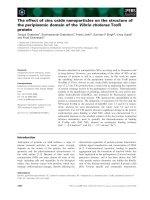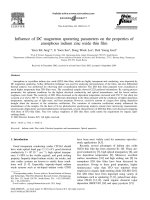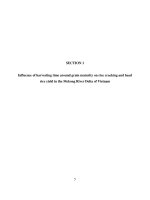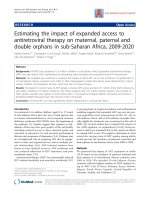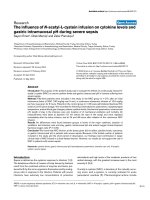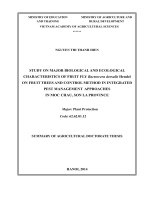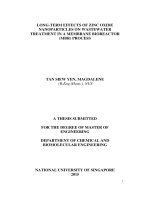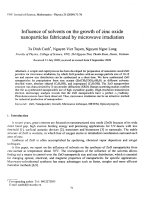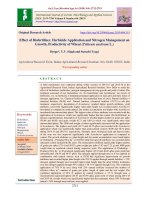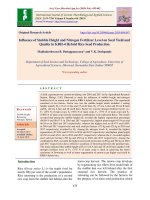Influence of green synthesized zinc oxide nanoparticles on seed germination and seedling growth in wheat (Triticum aestivum)
Bạn đang xem bản rút gọn của tài liệu. Xem và tải ngay bản đầy đủ của tài liệu tại đây (641.88 KB, 13 trang )
Int.J.Curr.Microbiol.App.Sci (2020) 9(5): 258-270
International Journal of Current Microbiology and Applied Sciences
ISSN: 2319-7706 Volume 9 Number 5 (2020)
Journal homepage:
Original Research Article
/>
Influence of Green Synthesized Zinc Oxide Nanoparticles on Seed
Germination and Seedling Growth in Wheat (Triticum aestivum)
Bhupendra Bhaskar Meher1, Shivraj Sahu1, Shivangi Singhal1,
Mayank Joshi1, Poonam Maan2 and Sneh Gautam1*
1
Department of Molecular Biology & Genetic Engineering, G.B.Pant University of
Agriculture & Technology, Pantnagar-263145, Uttarakhand, India
2
Department of Agriculture Biotechnology, S.V.P University of Agriculture & Technology,
Meerut-250110, U.P, India
*Corresponding author
ABSTRACT
Keywords
Zinc Oxide
Nanoparticles,
Catharanthus
roseus, Green
Synthesis,
Seed germination,
Seedling growth
Article Info
Accepted:
05 April 2020
Available Online:
10 May 2020
In present study, Zinc Oxide nanoparticles (ZnO NPs) were synthesized from leaf extract
of Catharanthus roseus by green synthesis method. The synthesized nanoparticles were
characterized by UV-visible spectrophotometry and Dynamic light spectroscopy (DLS)
that showed the synthesis of nanoparticles of average size 385 nm. To evaluate the effect
of ZnO NPs on seed germination, various concentrations of nanoparticles (20, 50 and 100
ppm) were used for the treatment of wheat seed but there was not observed any significant
effect on germination percentage, speed of germination and mean germination time.
However, root length, shoot length, seedling length, root dry weight, shoot dry weight,
seedling dry weight and seed vigour index (I and II) showed a significant increase at 50
ppm. Further, by increasing the concentration of ZnO NPs (at 100 ppm), a decrease was
observed in all parameters which stipulated the toxicity of synthesized nanoparticles at
higher concentration. Thus, the results of this study demonstrated that Catharanthus
roseus leaf can be used as a good source for green synthesis of ZnO NPs and the treatment
of ZnO NPs influenced the seedling growth and Seed vigour index significantly.
protection from biotic and abiotic stress
(Laware and Raskar, 2014).
Thus, Zn
deficiency in plant causes reduced leaf size,
leaf narcosis, stunted growth and decreased
seed vigor with low yield (Elhajand Unrine
2018).Besides these effects, a significant role
of Zn in seed germination and field
establishment of seedlings has been observed
Introduction
Zinc (Zn) is an essential micronutrient for all
living organism (Laware and Raskar, 2014).
In plants, it is necessary or protein synthesis,
sugar formation, phytohormone synthesis
(e.g. auxin), membrane function, seedling
vigor, photosynthesis and also for providing
258
Int.J.Curr.Microbiol.App.Sci (2020) 9(5): 258-270
in previous literatures (Yilmaz et al., 1998;
Rengel and Graham,1995; Cakmak, 2000;
Marschner, 1995). In India, soil has 36.5%Zn
deficiency and it is likely to increase
approximately
~63%
by
2025
( if
current trend of Zn losses continue.
Further, the redundant use of fertilizer also
causes the environmental pollution due to
wash out by rain that contaminates the ground
water and rivers (Deshpande et al., 2017).
Thus, bioavailability of Zn in soil, excessive
use of Zn fertilizer and environmental
pollution are still challenges which are need
to resolve by using a more potent strategy.
Currently, applications of Zinc oxide
nanoparticles (ZnO NPs)in agriculture are
being extensively explore to resolve the
problems associated with traditionally used
chemical fertilizer. The positive effect of ZnO
NPs has been estimated on plant growth and
yield in many previous studies (Munir et al.,
2018; Mahajan et al., 2011; Rameshraddy et
al., 2017; Du et al., 2011) due to their
controllable physical, chemical and biological
properties. Besides growth and yield, the
effect of ZnO NPs for influencing seed
germination has also been documented in
previous studies (Maity et al., 2018; Raskar
and Laware, 2014; Awasthi et al., 2017;
Solanki and Laura 2018; Prom-u-Thai et al.,
2012).
Cereals crops that are predominant food of
Indian population specially wheat, have
inherently low Zn concentration, and the
cultivation of this crop in Zn deficient soil
further decreases Zn content in grains (Das et
al., 2019) which ultimately cause the Zn
deficiency in human. Zn has significant role
in reproduction, development and immunity,
and Zn deficiency causes diarrhea, stunted
growth and immunological disorder in human
(Deshpande et al., 2017). It has been
estimated that around 26% of the Indian
population
is
deficient
in
Zn
( more than 2 billion people
are lacking in Zn and 800,000 people die
annually
due
to
Zn
deficiency
( />
In present study ZnO NPs has been
synthesized from Catharanthus roseus by
using green synthesis method. The
nanoparticles synthesized by using this
method are less toxic, cost effective and
uniform in size because it does not require
any toxic chemicals, high temperature,
pressure (Savithramma et al., 2011; Bhumi
and Savithramma,2014), and also does not
produce hazardous byproduct (El-Nour et al.,
2010; Stan et al., 2015) that is very common
in physical and chemical methods. Further,
Catharanthus roseus is an evergreen plant
contains 200 terpenoid based indole alkaloids
in stem, roots and leaves (Bhumi and
Savithramma, 2014). It also contains
secondary metabolites like vincristine,
serpentine, vinblastine, ajmalicine, phenolic
compounds (Gupta et al., 2018). Therefore,
the leaf extract of this plant can be used as a
To eliminate Zn deficiency from wheat plants,
different strategies are used. Soil application
of Zn fertilizer is a simple and effective
approach that has been extensively used to
exclude the Zn deficiency in soil (Kutman et
al., 2010) However, it is associated with some
problems. The bioavailability of Zn in soil or
absorption of Zn by the plant from the soil
depends on different soil properties such as
salinity, high pH and calcareous nature of
soil. The poor soil properties (high pH,
salinity, and calcareous nature of soil) lead to
formation of insoluble Zn salt that makes it
unavailable to the plants (Alloway, 2009). As,
micronutrient is required in very low amount
and also absorbed in very small quantity by
the plant so the excessive use of fertilizers is
wasted that increases the production cost of
crop and also leads to loss of soil fertility.
259
Int.J.Curr.Microbiol.App.Sci (2020) 9(5): 258-270
reducing material and surface stabilizing
agent to synthesize ZnO NPs (Bhumi and
Savithramma, 2014). The synthesized
nanoparticles were analyzed by DLS and
UVspectroscopy and further studied to
evaluate the effect on seed germination and
seedling growth.
2 hours. During the experiment, the pH was
maintained 12 by using 2 M NaOH. The
precipitate was centrifuged at 10,000 rpm for
10 minutes at 4°C and then it was washed two
times with double distilled water followed by
two times wash with ethanol to remove the
impurities. After washing, the precipitate was
collected and dried in an oven at 60°C
overnight which formed pale yellow colour
ZnO NPs.
Materials and Methods
Zinc acetate dehydrate, Sodium hydroxide,
Ethanol, Whatman No. 1 Filter paper were
purchased from Hi-Media, Mumbai. All
chemicals used in the experiments were
analytical grade.
Characterization of ZnONPs
UV-visible spectrophotometry
The synthesized ZnO NPs was observed
under
UV-visible
spectrophotometer
(GENESYS 10S UV-Vis Spectrophotometer
by Thermofisher Scientific). A solution of
100 ppm of ZnO NPs was prepared in double
distilled water and it was observed under UVvisible
spectrophotometer
after
ultrasonication (100 W, 40 KHz) for 30
minutes. The absorption spectrum was
recorded between 250-500 nm wavelengths.
The double distilled water was used as blank.
Preparation of periwinkle (Catharanthus
roseus) leaf extract
Fresh and healthy leaves of Periwinkle
(Catharanthus roseus) were taken and washed
with running water followed by 4-5 times
wash with double distilled water. The dried
leaves were crushed in mortar and pestle to
obtain fine powder. Subsequently, the fine
powder (10 gm) of cursed leaves were heated
at 65 °C in a water bath for 30 minutes in 100
ml of double distilled water until the colour
was not changed into yellow. After cooling,
the leaf extract was filtered by using
Whatman no.1 filter paper and the filtrate was
stored at 4 °C in a refrigerator for further use.
Dynamic light scattering (DLS)
The particle size distribution of the ZnONPs
was determined by DLS (Malvern NanoZS90). Synthesized ZnO NPs was added in
double distilled water to make 100 ppm
solution followed by ultrasonication at 40
KHz frequency. Then, 2 ml solution was
placed in a cuvette and observed under DLS
to determine the size of NPs. A constant
temperature of 25 ºC was maintained for the
sample holder.
Synthesis of ZnONPs from leaf extract
ZnO NPs were synthesized according to the
previous studies (Bhumi and Savithramma,
2014; Gupta et al., 2018). Firstly, 0.02 M
Zinc acetate dehydrate solution was prepared
by adding 0.35 gm Zinc acetate didydrate
(Zn(CH3COO)2.2H2O) in 80 ml distilled
water in a conical flask. The leaf extract (20
ml) was added into Zinc acetate dehydrate
solution by drop wise at 70 °C under stirring
condition. The stirring was done until the
precipitate was not formed which took around
Germination experiment
Germination experiment was carried out
according to the previous studies (Awasthi et
al., 2017; Solanki and Laura, 2018). To
perform the seed germination experiment,
260
Int.J.Curr.Microbiol.App.Sci (2020) 9(5): 258-270
different concentrations of ZnO NPs (20 ppm,
50 ppm and 100 ppm) were prepared by
adding the required amount of NPs in double
distilled water. Healthy and uniform size
seeds of WH 1105 wheat variety were taken
and soaked in respective concentrations of
NPs solutions. For control treatments, some
seeds were soaked in distilled water. Soaking
was done for 4 hours. The seeds were treated
with a little amount of thiram to avoid fungal
infections.
Speed of germination
Total number of germinated seeds was
counted every day from initial day to the final
day. It is also called Germination Index, and
was studied on the basis of the method
recommended by the Association of Official
Seed Analytics (AOSA, 1983).The following
formula is used to calculate the speed of
germination.
Petridishes of 15 cm were washed and 2
layers of towel papers were placed at the
bottom and moistened. In each petridish, 50
seeds were placed at equi-distance from each
other and radical end of seeds oriented
downwards. Then, the petridishes were
covered with the lid and kept in an incubator
at 22.5±1°C for 7 days.
Mean germination time
After the completion of the germination test
period, the mean germination time was
calculated on the basis of a formula given by
Bonner (1983).
Water was poured every day to keep the
optimum moisture level. The experiments
were performed in triplicate and Completely
Randomized Design (CRD) was used to
analyze the results. The following parameters
were recorded after germination experiments.
Root length, shoot length and seedling
length
Five seedlings were randomly selected from
each petridish on the final day. The root
length and shoot length were measured from
the base to the tip. The mean root length shoot
length were calculated and expressed in
centimeter (cm). The seedling length was
calculated by adding root length and shoot
length.
Germination percentage
The number of seeds germinated was counted
daily. Healthy and well-developed seedlings
with complete structures were considered
during counting. Germination studies were
performed according to the method
recommended by the Association of Official
Seed Analytics (AOSA, 1998) up to 7 days. A
seed was considered to germinate having
radical length at least 2 mm. The evaluation
was done on the final day and was calculated
as:
Root dry weight, shoot dry weight and
seedling dry weight
To calculate root dry weight and shoot dry
weight five seedling were randomly selected
from each petridish on the final day. The roots
from the base of each seedling were separated
and packed in a paper bag. Subsequently, the
paper bag was kept in a hot air oven at 65°C
for complete drying.
261
Int.J.Curr.Microbiol.App.Sci (2020) 9(5): 258-270
Mean root dry weight was calculated by
dividing total dry weight with the number of
seedlings. It was expressed in milligram (mg).
Same method was used to calculate shoot dry
weight. Seedling dry weight was calculated
by adding root dry weight and shoot dry
weight.
agent for the synthesis of ZnO NPs (Gupta et
al., 2018). Hence, Catharanthus roseus found
be a good source for synthesis of ZnO NPs.
Seed vigour index-I
UV-visible spectrophotometry analysis was
carried out to determine the synthesis of ZnO
NPs. A graph was plotted by taking
wavelength from 250 nm to 500 nm on X-axis
and absorbance on Y-axis. The peak
absorbance was observed at 372 nm
wavelength (Fig.2). The present finding is in
accordance with findings of Gupta et al.,
(2018), Ghorbani et al., (2015) and Kolekar et
al., (2011), which indicate the synthesis of
ZnO NPs.
Characterization of synthesized ZnO NPs
UV-visible spectrophotometry
It was calculated by multiplying germination
percentage and seedling length.
SVI- I= Germination% × Seedling length
Seed vigour index-II
It was calculated by multiplying germination
percentage and seedling dry weight
SVI- II= Germination% × Seedling dry
weight
Dynamic light scattering (DLS)
The particle size distribution was observed by
using dynamic light scattering technique. It is
a common technique used for finding particle
size distribution of colloidal solutions. In the
particle size distribution curve, average size
of synthesized ZnO NPs was found 385 nm
(Fig. 3). The polydisperity index was found to
be 0.259. According to Nagarajan and
Kuppusamy, (2013) samples having very
wide size distribution show more than 0.7
polydisperity index. However, the synthesized
ZnO NPs showed less polydispersity index
which indicated the uniform nature of
nanoparticles.
Statistical analysis
All the data of each parameter in all
experiments were subjected to statistical
analysis using Completely Randomized
Design in OPSTAT statistical program
developed by O.P. Sheoran, Associate
Professor, CCSHAU, Hisar.
Results and Discussion
Green synthesis of ZnO NPs
Nanoparticles synthesis of ZnO by using
periwinkle (Catharanthus roseus) leaves has
been shown in Fig.1 (a-f). The leaf extract of
Catharanthus roseus contains high amount of
secondary metabolites like serpentine,
vincristine, ajmalicine, alkaloids, phenolic
compounds etc.
Germination parameters (germination
percentage, speed of germination and mean
germination time)
Germination parameters like germination
percentage, speed of germination and mean
germination time are used to define the
efficiency of a seed to germinate.
Germination percentage is an estimate of the
These secondary metabolites act as reducing
agent, stabilizing agent as well as capping
262
Int.J.Curr.Microbiol.App.Sci (2020) 9(5): 258-270
viability of a population of seeds. However,
speed of germination represents the rate of
seed germination during the test period. While
mean germination time shows the average
time period required for the seeds to
germinate. There was not found any
significant effect on these parameters at
different concentrations of ZnO NPs. The data
pertaining to germination percentage, speed
of germination and mean germination time at
different concentrations of ZnO NPs has been
presented in Table 1.
Shoot length
In this experiment, the shoot length of control
seeds (without any treatment of ZnO NPs)
was found 8.2 cm. The significant increase in
seedling shoot length was observed in all
concentrations of ZnO NPs (20 ppm, 50 ppm
as well as 100 ppm).The data of shoot length
has been represented in Table 2. In 20 ppm
treatment, shoot length was obtained e 10.33
cm, which was 26% higher than the control
seedlings. Highest shoot length was observed
in 50 ppm ZnO NPs treatment that was 11.63
cm (41.87 % higher as compared to the
control seedlings). Further increase in
concentration of ZnO NPs caused decrease of
shoot length showing possible toxicity of ZnO
NPs.
These parameters (germination percentage,
speed of germination and mean germination
time) were not affected by the concentration
of ZnO NPs because they might be mainly
depend on the genetic factor. Similar result
has also been observed by Rawat et al.,
(2018). The petriplates showing germinated
seedlings at different concentration of ZnO
NPs have been shown in Fig.4.
Seedling length
The
seedling
length
at
different
concentrations of ZnO NPs has also been
shown in Table 2. The data revealed that the
seedling length was also found significantly
different at different concentrations of ZnO
NPs. The length of control seedling was
observed 19.77 cm. After treatment with 20
ppm concentration of ZnO NPs showed 22.1
cm seedling length which was 11.81 % higher
than the control ones and was statistically at
par with 100 ppm treatment. The highest
seedling length was observed at 50 ppm
concentration of ZnO NPs that was found
26.23 cm and 32.72 % higher than the control
seedlings. The seedling length at different
concentration has been shown in Fig. 5.
Root length
In the experiment, the root length of the wheat
seedlings varied significantly with change in
the concentration of ZnO NPs. The root
length of control seedlings was found to be
11.57 cm. When seed were treated with 20
ppm ZnO NPs, there was not found so much
change in the root length. However, seed
priming with 50 ppm ZnO NPs caused a
significant increase in the root length i.e., 14.6
cm, which was 26.23 % more than the
control.
Effect of 100 ppm ZnO NPs priming was
statistically at par with that of 50 ppm. When
seeds were treated with 100ppm ZnO NPs
concentration, a decrease was observed in
root length that was possibly due to the
toxicity of
nanoparticles
at
higher
concentration. The data of root length of
seedling after priming with ZnO NPs has been
shown in Table 2.
The increase in seedling length might be due
to the production of auxin in the seedling
(Zhao, 2010; Liu et al., 2013) because Zinc
act as the precursor for synthesis of auxin.
After the treatment of different concentrations
of the ZnONPs, a sufficient amount of Zinc
was available for auxin synthesis to enhance
the length of the seedling.
263
Int.J.Curr.Microbiol.App.Sci (2020) 9(5): 258-270
However, the higher concentration of NPs
might lead to toxicity which retarded
metabolism of embryo cells, and hence a
decrease was observed in length of root, shoot
and the whole seedling. Previously, Prasad et
al., (2012), Lin and Xing (2007) and Maity et
al., (2018) also observed the similar effect of
ZnO NPs during seed germination.
Seedling dry weight
The seedling dry weight was calculated by
adding root and shoot dry weight. The
experiment showed significant difference in
seedling dry weight with change in the
concentration of ZnO NPs (Table 3). The
seedling dry weight was observed 16.67 mg
in case of the ZnO NPs free seedlings. The
seedling dry weight was increased with
increase the concentration of ZnO NPs upto
50 ppm. It was increased by 14 % and 34.61
% as compared to control seedling dry weight
at 20 ppm and 50 ppm treatments
respectively. But, at 100 ppm ZnO NPs
concentration, the dry weight of seedling was
reduced that indicated possible toxicity of
ZnO NPs in the seedling at this concentration.
Root dry weight
In the experiment, a significant increase in
root dry weight was obtained at 50 ppm
concentration of ZnO NPs. The control
seedling had 8.1 mg root dry weight. After the
treatment of 50 ppm ZnO NPs, highest root
dry weight was observed i.e., 10.23 mg which
was 26.34 % higher than the control
seedlings.
The seedlings dry weight showed a pattern
similar to seedling length (at 50 ppm ZnO
NPs, maximum seedling dry weight was
observed). Similar pattern was also observed
in case of dry weight of root and shoot.
Comparable results have also been observed
by Raskarand Laware (2014), Solanki and
Laura (2018) and Narendhran et al., (2016) in
previous studies.
The 20 ppm and 100 ppm treatments showed
8.2 mg and 9.17 mg root dry weight
respectively that were not significantly
different from the control one. The data
related to the dry weight of roots at different
concentrations of ZnO NPs treatment has
been shown in Table 3.
Shoot dry weight
Seed vigour index (I and II)
The shoot dry weight varied significantly with
change in the concentrations of ZnO NPs. The
data has been represented in Table 3. The
shoot dry weight was observed 8.57 mg in
case of the control seedlings. After 20 ppm
treatment, the dry weight of shoots was found
10.8 mg which was 26 % higher as compared
to control seedlings while 42.42 % increase
was observed at 50 ppm treatments.
Seed vigour is the activity and performance of
the seed during germination and seedling
emergence. The data related to seed vigour
index-I and II have been shown in Table 4.
Seed vigour index–I calculate germination
percentage and seedling growth (on the basis
of length). On the other hand, Seed vigour
index –II estimate germination percentage and
seedling growth (on the basis of seedling dry
weight).
Further, the dry weight of shoot was
decreased with increase the concentration of
ZnO NPs, and 100 ppm concentration showed
a reduction in the dry weight of shoot which
was 10.67 mg and was statistically at par with
the 20 ppm treatment of ZnO NPs.
In this experiment significant variation in the
SVI-I was noted with change in the ZnO NPs
concentration. In the control seedlings, SVI-I
was observed 1857.
264
Int.J.Curr.Microbiol.App.Sci (2020) 9(5): 258-270
Table.1 Germination percentage, speed of germination and mean germination time of seed
treated with different concentrations of ZnO NPs
Concentration of
ZnO NPs (ppm)
0
20
50
100
SE ±
CD (5%)
Germination
percentage
94.00
96.00
99.33
98.67
1.37
NS
Speed of
germination
14.77
15.35
16.28
15.84
0.36
NS
Mean germination
time (days)
3.17
3.21
3.26
3.31
0.09
NS
Table.2 Length of root, shoot and seedling treated at different concentrations of ZnO NPs
Concentration of
ZnO NPs (ppm)
0
20
50
100
SE ±
CD (5%)
Root length (cm)
Shoot length (cm)
Seedling length (cm)
11.57
11.77
14.60
13.00
0.68
2.26
8.20
10.33
11.63
10.17
0.41
1.37
19.77
22.10
26.23
23.17
0.70
2.31
Table.3 Dry weight of root, shoot and seedling treated with different concentrations of ZnO NPs
Concentration
ZnO NPs (ppm)
0
20
50
100
SE ±
CD (5%)
of Root
dry Shoot dry weight (mg) Seedling dry weight
weight (mg)
(mg)
8.10
8.57
16.67
8.20
10.80
19.00
10.23
12.20
22.43
9.17
10.67
19.83
0.46
0.44
0.56
1.54
1.47
1.84
Table.4 Seed Vigour Index-I and Seed Vigour Index-II of seedlings treated with different
concentrations of ZnO NPs
Concentration of ZnO NPs (ppm)
0
20
50
100
SEm±
CD (5%)
Seed Vigour Index- I
1857
2123
2605
2286
72.59
240.42
265
Seed Vigour Index- II
1566
1825
2228
1957
58.49
193.72
Int.J.Curr.Microbiol.App.Sci (2020) 9(5): 258-270
Fig. 1 Synthesis of ZnO NPs: (a) Prepared leaf extract; (b) Prepared 0.02 M zinc acetate
dehydrate solution; (c) Leaf extract added to zinc acetate dihydrate; (d) Colloidal appearance
after 2 hours of stirring; (e) Precipitate of ZnO NPs; (f) ZnO NPs powder formed after oven
drying of precipitate
Fig.2 UV-visible spectrophotometry of synthesized ZnO NPs
266
Int.J.Curr.Microbiol.App.Sci (2020) 9(5): 258-270
Fig.3 Dynamic light Scattering of Synthesized ZnO NPs
Fig.4 Petriplates containing seedlings treated with different concentrations of ZnO NPs; (a) 0
ppm; (b) 20 ppm; (c) 50 ppm; (d) 100 ppm
Fig.5 Seedlings of wheat treated with different concentrations of ZnO NPs; (a) 0 ppm;
(b) 20 ppm; (c) 50 ppm; (d) 100 ppm
267
Int.J.Curr.Microbiol.App.Sci (2020) 9(5): 258-270
While after 20 ppm ZnO NPs treatment,
significant increase was found that was 14.31
% higher than the control seedling. Highest
SVI-I was observed at 50 ppm ZnO NPs
treatment with 40.28 % increased as
compared to the control seedlings. However,
after100 ppm ZnO NPs treatment, the SVI-I
was significantly lower than the 50 ppm
treated seedlings which showed possible
toxicity of ZnO NPs at concentration higher
than 50 ppm. The variation in the seed vigour
index-I due to concentration of ZnO
nanoparticles might be because of the
seedling length and germination percentage as
seed vigour index-I is the product of seedling
length and the germination percentage of the
seedlings.
However, a significant increase was observed
in root length, shoot length, seedling length,
root dry weight, shoot dry weight, seedling
dry weight, seed vigour index I and seed
vigour index II at different concentrations of
ZnO NPs treatment. The maximum increase
in all parameters was exhibited at 50 ppm
concentration.
Further, increase in
concentration (100 ppm) showed a reduction
in all parameters that was possible due to the
toxicity of
nanoparticles
at
higher
concentration.
Acknowledgment
Authors are thankful to Department of
Biotechnology, Government of India for
providing the grant to carry out the study.
ZnO NPs treatments also had a significant
effect on the SVI-II of wheat (Table 4). SVIII was observed 1566 in control seedlings.
After 20 ppm ZnO NPs treatment, a
significant increase of 16.57 % was found in
SVI-II than control. Highest SVI-II was
observed at 50 ppm ZnO NPs treatment,
which was 42.32 % higher than the control
seedlings. Further, increase in concentration
of ZnO NPs (100 ppm) decrease in SVI-II
was observed. The variation in the seed
vigour index-II with different concentrations
of ZnO nanoparticles might be due to the
seedling dry weight and germination
percentage as seed vigour index-II is the
product of seedling dry weight and the
germination percentage of the seedlings.
Similar results were also examined by Rawat
et al., (2018).
References
Alloway, B. J. 2009. Soil factors associated with
zinc
deficiency
in
crops
and
humans. Environmental
Geochemistry
and Health. 31(5): 537-548.
Association of Official Seed Analysis (AOSA).
1983. Seed vigor testing handbook,
Contribution No. 32 to the Handbook of
seed testing. Association of official seed
analysis. Springfield.
Association of Official Seed Analysis (AOSA).
1998. Rules of testing seeds. Journal of
Seed Technology. 12:1-11
Awasthi, A., Bansal, S., Jangir, L.K., Awasthi, G.,
Awasthi, K. K. and Awasthi, K. 2017.
Effect of ZnO nanoparticles on
germination of Triticumaestivum seeds.
In Macromolecular Symposia. 376(1):
1700043.
Bhumi, G., and Savithramma, N. 2014. Biological
synthesis of zinc oxide nanoparticles from
Catharanthus roseus (L.) G. Don. Leaf
extract and validation for antibacterial
activity. International Journal of Drug
Development and Research. 6(1): 208214.
Cakmak, I. 2000. Possible Roles of Zinc in
Protecting Plant Cells from Damage by
Reactive
Oxygen
Species.
New
In conclusion, ZnO NPs can be synthesized
by using Catharanthus roseus as a reducing
agent. UV-visible spectroscopy and DLS
indicated the synthesis of ZnO NPs.
Germination percentage, speed of germination
and mean germination time were not found
significantly influenced by the treatment of
different concentrations of ZnO NPs.
268
Int.J.Curr.Microbiol.App.Sci (2020) 9(5): 258-270
Phytology. 146: 185-205.
Das, S., Green, A., and Fan, M. X. 2019. Zinc
Deficiency in Indian Soils is Associated
with Low Crop Productivity and Crop
Quality. Better Crops - South Asia 11-14.
Deshpande, P., Dapkekar, A., Oak, M. D.,
Paknikar, K. M., &Rajwade, J. M. 2017.
Zinc
complexed
chitosan/TPP
nanoparticles: a promising micronutrient
nanocarrier
suited
for
foliar
application. Carbohydrate Polymer. 165:
394-401.
Du, W., Sun, Y., Ji, R., Zhu, J., Wu, J. and Guo,
H. 2011. TiO 2 and ZnO nanoparticles
negatively affect wheat growth and soil
enzyme
activities
in
agricultural
soil. Journal
of
Environmental
Monitoring. 13(4): 822-828.
Elhaj, B., Z. and Unrine, J.M. 2018.
Functionalized-ZnO-nanoparticle
seed
treatments to enhance growth and zn
content of wheat (Triticumaestivum)
seedlings. Journal of agricultural and food
chemistry. 66(46): 12166-12178.
El-Nour, K. M. A., Eftaiha, A.A., Al-Warthan, A.
and Ammar, R. A. 2010. Synthesis and
applications of silver nanoparticles.
Arabian Journal of Chemistry. 3(3): 135140.
Ghorbani, H. R., Mehr, F. P., Pazoki, H. and
Rahmani, B. M. 2015. Synthesis of ZnO
nanoparticles
by
precipitation
method. Oriental
Journal
of
Chemistry. 31(2): 1219-1221.
Gupta, M., Tomar, R. S., Kaushik, S., Mishra, R.
K. and Sharma, D. 2018. Effective
antimicrobial activity of green ZnOnano
particles
of
Catharanthus
roseus. Frontiers in microbiology. 9:
2030.
/> />Kolekar, T. V., Yadav, H. M., Bandgar, S. S. and
Deshmukh, P. Y. 2011. Synthesis by sol–
gel method and characterization of ZnO
nanoparticles. Indian Streams Research
Journal. 1(1).
Kutman, U. B., Yildiz, B., Ozturk, L. and
Cakmak, I., 2010. Biofortification of
durum wheat with zinc through soil and
foliar applications of nitrogen. Cereal
Chemistry. 87(1): 1-9.
Laware, S. L. and Raskar, S. 2014. Influence of
zinc oxide nanoparticles on growth,
flowering and seed productivity in
onion. International Journal of Current
Microbiology and applied Science. 3(7):
874-881.
Lin, D. and Xing, B. 2007. Phytotoxicity of
nanoparticles:
inhibition
of
seed
germination
and
root
growth. Environmental Pollution. 150(2):
243-250.
Liu, X., Zhang, H., Zhao, Y., Feng, Z., Li, Q.,
Yang, H.Q., Luan, S., Li, J. and He, Z. H.
2013. Auxin controls seed dormancy
through stimulation of abscisic acid
signaling by inducing ARF-mediated
ABI3
activation
in
Arabidopsis. Proceedings of the National
Academy of Sciences. 110(38): 1548515490.
Mahajan, P., Dhoke, S. K. and Khanna, A. S.
2011. Effect of nano-ZnO particle
suspension on growth of mung
(Vignaradiata) and gram (Cicerarietinum)
seedlings
using
plant
agar
method. Journal of Nanotechnology.
2011.
Maity, A., Natarajan, N., Vijay, D., Srinivasan,
R., Pastor, M. and Malaviya, D. R. 2018.
Influence of metal nanoparticles (NPs) on
germination and yield of oat (Avena
sativa)
and
berseem
(Trifoliumalexandrinum). Proceedings of
the National Academy of Sciences, India
Section B: Biological Sciences. 88(2):
595-607.
Marschner, H. 1995. Mineral Nutrition of Higher
Plants. (2nd Ed.) Academic Press,
London. pp 889.
Munir, T., Rizwan, M., Kashif, M., Shahzad, A.,
Ali, S., Amin, N., Zahid, R., Alam,
M.F.E. and Imran, M., 2018. Effect of
zinc oxide nanoparticles on the growth
and
Zn
uptake
in
wheat
(Triticumaestivum L.) By seed priming
method. Digest
Journal
of
Nanomaterials&Biostructures.
13(1):
315-323.
Nagarajan, S. and Kuppusamy, K. A. 2013.
Extracellular synthesis of zinc oxide
269
Int.J.Curr.Microbiol.App.Sci (2020) 9(5): 258-270
nanoparticle using seaweeds of gulf of
Mannar,
India.
Journal
of
Nanobiotechnology. 11(1): 39.
Narendhran, S. and Sivaraj, R. 2016. Biogenic
ZnO nanoparticles synthesized using L.
aculeata leaf extract and their antifungal
activity
against
plant
fungal
pathogens. Bulletin
of
Materials
Science. 39(1): 1-5.
Prasad, T. N. V. K. V., Sudhakar, P.,
Sreenivasulu, Y., Latha, P., Munaswamy,
V., Reddy, K. R. and Pradeep, T. 2012.
Effect of nanoscale zinc oxide particles on
the germination, growth and yield of
peanut. Journal of Plant Nutrition. 35(6):
905-927.
Prom‐ u‐ thai, C., Rerkasem, B., Yazici, A. and
Cakmak, I. 2012. Zinc priming promotes
seed germination and seedling vigor of
rice. Journal of Plant Nutrition and Soil
Science. 175(3): 482-488.
Rameshraddy, G. J., Pavithra, G.J., Mahesh, S.,
Geetha, K.N. and Shankar, A.G., 2017.
Seed priming and foliar spray with nano
zinc improves stress adaptability and seed
zinc content without compromising seed
yield in ragi (Finger millet). International
Journal of Pure Applied Bioscience. 5(3):
251-258.
Raskar, S.V. and Laware, S.L., 2014. Effect of
zinc oxide nanoparticles on cytology and
seed germination in onion. International
Journal of Current Microbiology and
Applied Science.3(2): 467-473.
Rawat, P. S., Kumar, R., Ram, P. and Pandey, P.
2018. Effect of Nanoparticles on Wheat
Seed
Germination
and
Seedling
Growth. International
Journal
of
Agricultural
and
Biosystems
Engineering. 12(1): 13-16.
Rengel, Z. and Graham, R. D., 1995. Importance
of seed Zn content for wheat growth on
Zn-deficient soil. Plant and Soil. 173(2):
259-266.
Savithramma, N., Rao, M. L., Rukmini, K. and
Devi, P. S. 2011. Antimicrobial activity of
silver nanoparticles synthesized by using
medicinal plants. International Journal of
ChemTech Research. 3(3):1394-1402.
Solanki, P. and Laura, J. S. 2018. Effect of ZnO
nanoparticles on seed germination and
seedling
growth
in
wheat
(Triticumaestivum). Journal
of
Pharmacognosy
and
Phytochemistry, 7(5): 2048-2052.
Stan, M., Popa, A., Toloman, D., Dehelean, A.,
Lung, I. and Katona, G., 2015. Enhanced
photocatalytic degradation properties of
zinc oxide nanoparticles synthesized by
using plant extracts. Materials Science in
Semiconductor Processing. 39: 23-29.
Yilmaz, A., Ekiz, H., Gültekin, I., Torun, B.,
Barut, H., Karanlik, S. and Cakmak, I.
1998. Effect of seed zinc content on grain
yield and zinc concentration of wheat
grown in zinc‐ deficient calcareous
soils. Journal of Plant Nutrition. 21(10):
2257-2264.
Zhao, Y. 2010. Auxin biosynthesis and its role in
plant development. Annual review of
plant biology. 61: 49-64.
How to cite this article:
Bhupendra Bhaskar Meher, Shivraj Sahu, Shivangi Singhal, Mayank Joshi, Poonam Maan and
Sneh Gautam. 2020. Influence of Green Synthesized Zinc Oxide Nanoparticles on Seed
Germination and Seedling Growth in Wheat (Triticum aestivum). Int.J.Curr.Microbiol.App.Sci.
9(05): 258-270. doi: />
270
